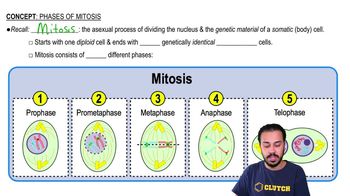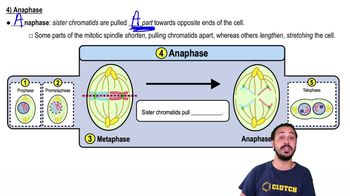Table of contents
- 1. Introduction to Biology2h 42m
- 2. Chemistry3h 40m
- 3. Water1h 26m
- 4. Biomolecules2h 23m
- 5. Cell Components2h 26m
- 6. The Membrane2h 31m
- 7. Energy and Metabolism2h 0m
- 8. Respiration2h 40m
- 9. Photosynthesis2h 49m
- 10. Cell Signaling59m
- 11. Cell Division2h 47m
- 12. Meiosis2h 0m
- 13. Mendelian Genetics4h 44m
- Introduction to Mendel's Experiments7m
- Genotype vs. Phenotype17m
- Punnett Squares13m
- Mendel's Experiments26m
- Mendel's Laws18m
- Monohybrid Crosses19m
- Test Crosses14m
- Dihybrid Crosses20m
- Punnett Square Probability26m
- Incomplete Dominance vs. Codominance20m
- Epistasis7m
- Non-Mendelian Genetics12m
- Pedigrees6m
- Autosomal Inheritance21m
- Sex-Linked Inheritance43m
- X-Inactivation9m
- 14. DNA Synthesis2h 27m
- 15. Gene Expression3h 20m
- 16. Regulation of Expression3h 31m
- Introduction to Regulation of Gene Expression13m
- Prokaryotic Gene Regulation via Operons27m
- The Lac Operon21m
- Glucose's Impact on Lac Operon25m
- The Trp Operon20m
- Review of the Lac Operon & Trp Operon11m
- Introduction to Eukaryotic Gene Regulation9m
- Eukaryotic Chromatin Modifications16m
- Eukaryotic Transcriptional Control22m
- Eukaryotic Post-Transcriptional Regulation28m
- Eukaryotic Post-Translational Regulation13m
- 17. Viruses37m
- 18. Biotechnology2h 58m
- 19. Genomics17m
- 20. Development1h 5m
- 21. Evolution3h 1m
- 22. Evolution of Populations3h 52m
- 23. Speciation1h 37m
- 24. History of Life on Earth2h 6m
- 25. Phylogeny2h 31m
- 26. Prokaryotes4h 59m
- 27. Protists1h 12m
- 28. Plants1h 22m
- 29. Fungi36m
- 30. Overview of Animals34m
- 31. Invertebrates1h 2m
- 32. Vertebrates50m
- 33. Plant Anatomy1h 3m
- 34. Vascular Plant Transport1h 2m
- 35. Soil37m
- 36. Plant Reproduction47m
- 37. Plant Sensation and Response1h 9m
- 38. Animal Form and Function1h 19m
- 39. Digestive System1h 10m
- 40. Circulatory System1h 57m
- 41. Immune System1h 12m
- 42. Osmoregulation and Excretion50m
- 43. Endocrine System1h 4m
- 44. Animal Reproduction1h 2m
- 45. Nervous System1h 55m
- 46. Sensory Systems46m
- 47. Muscle Systems23m
- 48. Ecology3h 11m
- Introduction to Ecology20m
- Biogeography14m
- Earth's Climate Patterns50m
- Introduction to Terrestrial Biomes10m
- Terrestrial Biomes: Near Equator13m
- Terrestrial Biomes: Temperate Regions10m
- Terrestrial Biomes: Northern Regions15m
- Introduction to Aquatic Biomes27m
- Freshwater Aquatic Biomes14m
- Marine Aquatic Biomes13m
- 49. Animal Behavior28m
- 50. Population Ecology3h 41m
- Introduction to Population Ecology28m
- Population Sampling Methods23m
- Life History12m
- Population Demography17m
- Factors Limiting Population Growth14m
- Introduction to Population Growth Models22m
- Linear Population Growth6m
- Exponential Population Growth29m
- Logistic Population Growth32m
- r/K Selection10m
- The Human Population22m
- 51. Community Ecology2h 46m
- Introduction to Community Ecology2m
- Introduction to Community Interactions9m
- Community Interactions: Competition (-/-)38m
- Community Interactions: Exploitation (+/-)23m
- Community Interactions: Mutualism (+/+) & Commensalism (+/0)9m
- Community Structure35m
- Community Dynamics26m
- Geographic Impact on Communities21m
- 52. Ecosystems2h 36m
- 53. Conservation Biology24m
11. Cell Division
Phases of Mitosis
Problem 9`
Textbook Question
The light micrograph shows dividing cells near the tip of an onion root. Identify a cell in each of the following stages: prophase, prometaphase, metaphase, anaphase, and telophase. Describe the major events occurring at each stage.
<IMAGE>
 Verified step by step guidance
Verified step by step guidance1
Examine the light micrograph of the onion root tip to identify cells in different stages of mitosis. Look for visual cues such as the arrangement and appearance of chromosomes.
Identify a cell in prophase: During prophase, chromosomes condense and become visible under the microscope. The nuclear envelope begins to break down, and the mitotic spindle starts to form.
Identify a cell in prometaphase: In prometaphase, the nuclear envelope is completely disintegrated, and spindle fibers attach to the kinetochores of chromosomes. Chromosomes begin to move towards the center of the cell.
Identify a cell in metaphase: During metaphase, chromosomes align at the metaphase plate, which is the equatorial plane of the cell. The spindle fibers are fully attached to the kinetochores of each chromosome.
Identify a cell in anaphase and telophase: In anaphase, sister chromatids are pulled apart towards opposite poles of the cell. In telophase, the chromatids reach the poles, the nuclear envelope re-forms around each set of chromosomes, and the chromosomes begin to de-condense.
 Verified video answer for a similar problem:
Verified video answer for a similar problem:This video solution was recommended by our tutors as helpful for the problem above
Video duration:
1mPlay a video:
Was this helpful?
Key Concepts
Here are the essential concepts you must grasp in order to answer the question correctly.
Cell Division
Cell division is the process by which a parent cell divides into two or more daughter cells. In eukaryotes, this involves mitosis, where the nucleus divides, and cytokinesis, where the cytoplasm divides. Understanding cell division is crucial for identifying the stages of mitosis in the onion root tip micrograph.
Recommended video:
Guided course

Importance of Cell Division
Stages of Mitosis
Mitosis consists of several stages: prophase, prometaphase, metaphase, anaphase, and telophase. Each stage is characterized by specific events, such as chromosome condensation in prophase, alignment at the metaphase plate, and separation of sister chromatids during anaphase. Recognizing these stages helps in identifying them in the micrograph.
Recommended video:
Guided course

Stages of Photosynthesis
Chromosome Behavior
During mitosis, chromosomes undergo distinct changes, including condensation, alignment, and separation. In prophase, chromosomes condense and become visible; in metaphase, they align at the cell's equator; and in anaphase, sister chromatids are pulled apart. Observing these behaviors is essential for describing the major events at each stage in the micrograph.
Recommended video:
Guided course

Behavior
Related Videos
Related Practice



















